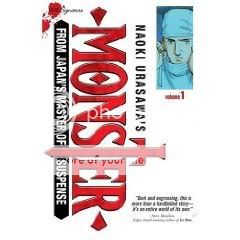
Naoki Urasawa’s Monster Vols. 1-3
Naoki Urasawa, writer/artist
Viz, 2006
208-224 pages each
$9.99 each
[First, a programming note. Because I read so many comics and write so many reviews, I end up reading and reviewing mostly self-contained works rather than long runs. The problem is I’ve been at this for long enough that a majority of the books on my “unread” shelves (plural) are part of big ol’ multi-volume series. Which is exciting! I love plunging into a world for as long as it’ll have me, that’s one of the great pleasures art can provide. But it presents a conundrum for a critic who posts three reviews a week, because on the one hand I’m accustomed to reviewing a complete work, so a big part of me would prefer to complete a series before reviewing it. Moreover, I don’t wanna bury the site in piecemeal reviews of a couple-three volumes at a time, just so no one, me or you, gets bored. On the other hand, I really like holding myself to this schedule, it’s fun and it’s been good for me as a writer and just as a reader too. And there’s probably something to be said for posting more than one review for a given series, tackling earlier and later material from it separately, seeing how both the material and my take on it change over the duration of its run. So for now that’s the direction I’m headed with this particular series, though in the future I may go ahead and stop posting reviews until I get a whole run read. Who knows? Life is a mystery. And so is…]
Naoki Urasawa’s Monster, the series that as best I can tell broke him in America, is a strange beast. You’ve got four distinct, and perhaps competitive, forces at play in these early volumes. Number one is the elevator-pitch concept: Brilliant doctor risks his career to save the life of an orphan, only for the orphan to grow up into a serial killer. Number two is the way that high concept broadens and complicates into a globetrotting (well, Germany-trotting, so far) political-thriller pageturner/potboiler. Number three is the frothy pulpy soapy melodrama of it all, with characters yelling about the sanctity of human life and children in peril and a villain who is repeatedly labeled “pure evil” Michael Meyers-style and geniuses in their fields who throw it all away for the sake of the job and on and on. Number four, maybe the most interesting force at work, is this undercurrent of meaty and specific social issues that weave in and out of the genre business: German reunification and its discontents, being an Asian immigrant in Europe, medical ethics and hospital politics, child abuse (depicted in a shockingly frank fashion at times).
And as I’ve pointed out in the past, Urasawa’s art plays it all totally straight. It’s just pure craft, existing for the sole purpose of getting the story across and over. The people look cartoony, yes–they remind me of Disney house-style people, not in terms of their specific look but in the way they function as vehicles for immediately intelligible ideas and emotions. The clarity they comprise is so…overpowering, I guess is the word, so able to lodge in your brain, that this morning as I was thinking over Footnotes in Gaza again, the people of Rafah appeared to me in Urasawa style, not Joe Sacco style. My point, though, is that apart from their cartooniness and penchant for yelling, which could point toward the pulp melodrama as the dominant thread for the series, the character designs and the art in general really don’t tip their hand as to what you “should” be making of all this. Is it “just” addictive thriller storytelling? Are we meant to take the various waxings philosophical seriously, is the thriller stuff and the in-your-face villainy and the way we’ve met four or five people so good at their jobs that it’s broken up their marriages intended as a palatable container for it? Or is it vice versa? This is what American serialized genre-entertainment fans might call the Lost question (a comparison I’ve made with Urasawa’s stuff before). Frankly, I think that in Monster‘s case the pulpy stuff wins the day hands down–the issue-y stuff is reeeeeeeally broad. But I suppose the point here, in the end, is that if you can read the first volume and not want to read the next 17, you are made of sterner stuff than I.
Tags: comics, comics reviews, Comics Time, reviews

Vaguely o/t:
I spent the last week doing three slowww sequential re-reads of the first seven vols. of 20th Century Boys, and am fairly certain that I’ve found two panels of an adult Sadakiyo without his mask. Not that they’re hard to spot, but I glossed over ’em the first two times.
The great thing is, the author’s as slippery as either Johann or Friend. There’s so much hearsay & noise surrounding Sadakiyo that my being able to pick him out of a crowd doesn’t do a damn thing. Yet.
Speaking of noise: I wonder about the significance of Sadakiyo’s rumored near-death (or abduction?) experience. Between that & his ‘amiability’ he’s got a lot in common with Johann, doesn’t he? Urasawa’s starting to look like a ringer for Grant Morrison…